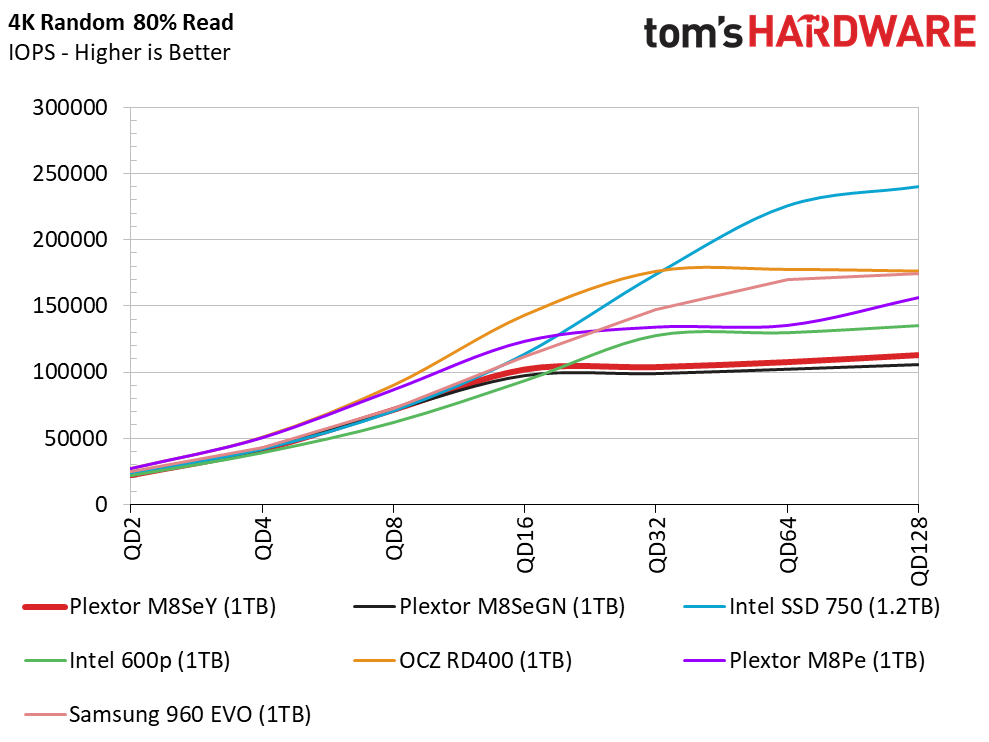Plextor M8Se NVMe SSD Review
Why you can trust Tom's Hardware
1TB NVMe SSD Performance
Comparison Products
The market gained a few new 1TB NVMe SSDs since our last review, but this capacity point still suffers from the Great NAND Shortage of 2016. Thankfully, we can see the light at the end of the tunnel thanks to new flash technology. For this review, we gathered the most popular 1TB models available (except the elusive 960 Pro 1TB).
Most of these products still use MLC NAND flash. The MLC group consists of the Intel SSD 750 1.2TB, OCZ RD400 and RD400A in M.2-only, and the Plextor M8Pe.
There are four products with TLC flash. The Samsung 960 EVO 1TB is one of the most popular NVMe SSDs on the market. It's flanked by the Intel 600p, which is also very popular due to its low cost and overall value compared to SATA offerings. We have two Plextor M8Se models in our test pool. The M8Sey is an add-in card with a full heat sink, and the M8SeGN is an M.2 drive without a heat sink. We did not receive an M8SeG M.2 SSD with the thin aluminum heat sink.
Sequential Read Performance
To read about our storage tests in-depth, please check out How We Test HDDs And SSDs. We cover four-corner testing on page six of our How We Test guide.


We ramp up the sequential read workload by increasing the queue depth (QD). It's possible to reach higher throughput with the addition of more workers, but we use a single worker because most software still accesses the storage system the same way it has for the last twenty years. We will add more workers when more software emerges that can fully utilize the NVMe protocol.
We didn't expect the Plextor M8Se drives to fall to the bottom of our sequential read test. We also didn't expect the bare drive to outperform the add-in card, which has a heat sink to eliminate thermal throttling.
Sequential Write Performance


Unlike the OCZ RD400, neither M8Se exhibited the tell-tale signs of thermal throttling during our sequential write test. The M8Se's sequential write performance is quite low and even trails the Intel 600p 1TB through most of the test. The low write performance may be why we haven't seen other companies bring the Marvell 88SS1093 controller to market with Toshiba 15nm TLC even though the controller has been available for some time.
Get Tom's Hardware's best news and in-depth reviews, straight to your inbox.
Random Read Performance



The M8Se NVMe SSDs outperform the Intel 600p 1TB in our random read tests, but performance is still much lower than we expected. The M8Pe with MLC NAND didn't launch with the performance you see in our testing. We retested the drive with its sixth firmware revision since the initial launch. The M8Se doesn't have an update yet, but given Plextor's frequent updates on other high-performance models, we expect to see at least one update before the company retires the product.
Random Write Performance


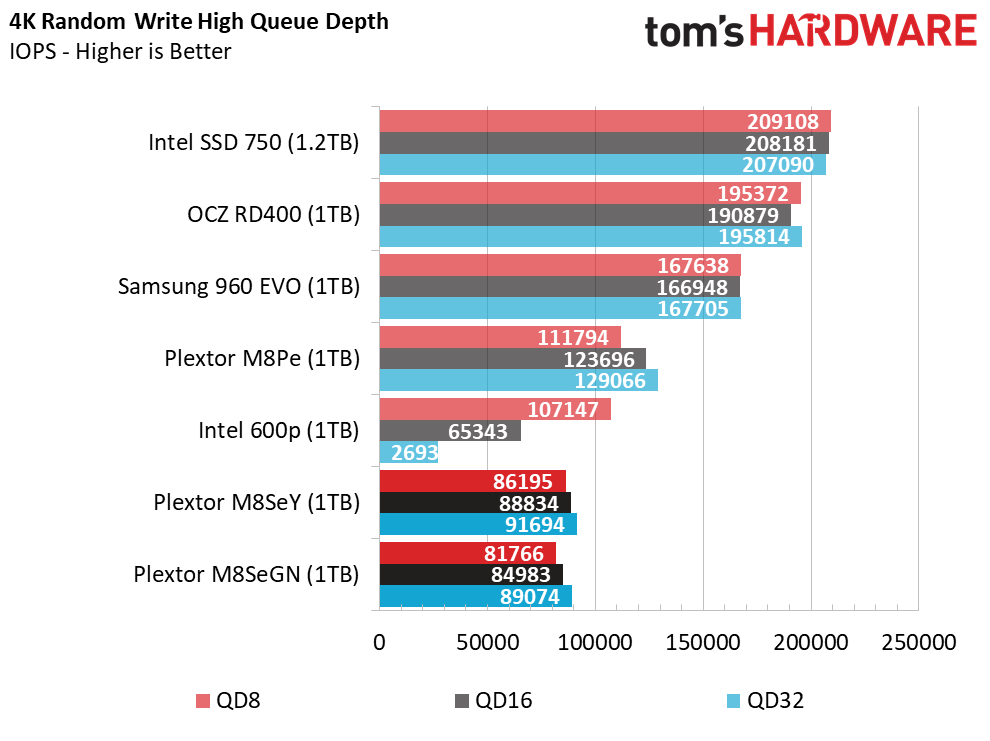
The low random write performance reveals the M8Se could use a firmware update to address some performance concerns. The heat sink on the M8SeY AIC doesn't offer too much help with the performance, either. We did observe a slight difference with this series in our four-corner tests, but it's not enough to pay extra for the heat sink.
80 Percent Mixed Sequential Workload
We describe our mixed workload testing in detail here and describe our steady state tests here.
The low random write performance pulls down mixed sequential performance. The M8Pe with MLC flash delivered a higher result across the queue depth range, but it also scored less than we expected. The tri-core processor appears to become overwhelmed with a mix of incoming and outgoing data.
80 Percent Mixed Random Workload
We see similar results with the mixed random workload. The M8Se drives still deliver better performance than competing SATA SSDs.
Sequential Steady-State



The mixed workload performance falls even lower during the steady state test. These are the lowest measurements we've seen with an NVMe-based product. This should concern users that store a lot of data on the SSD instead of shuffling cold data to a secondary volume. We haven't measured performance this low in a long time -- even with DRAMless SATA drives.
Random Steady-State


For what it's worth, the M8Se SSDs deliver consistent random steady state performance. We still wouldn't recommend this series for a RAID array because the price tag is already higher than many products with MLC flash.
PCMark 8 Real-World Software Performance
For details on our real-world software performance testing, please click here.

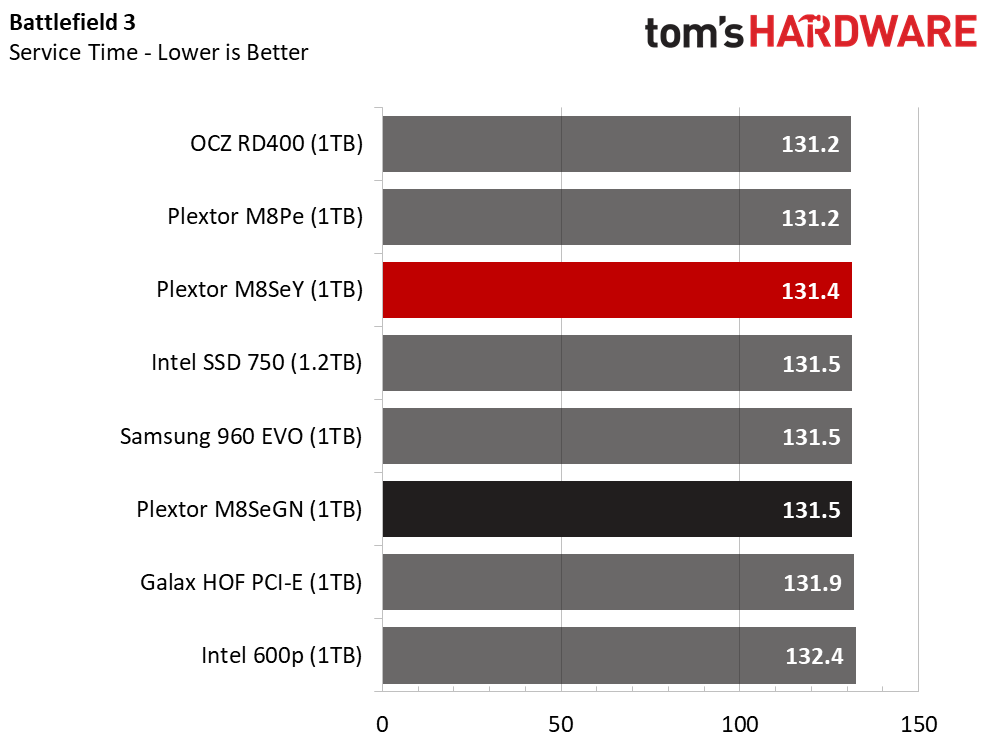







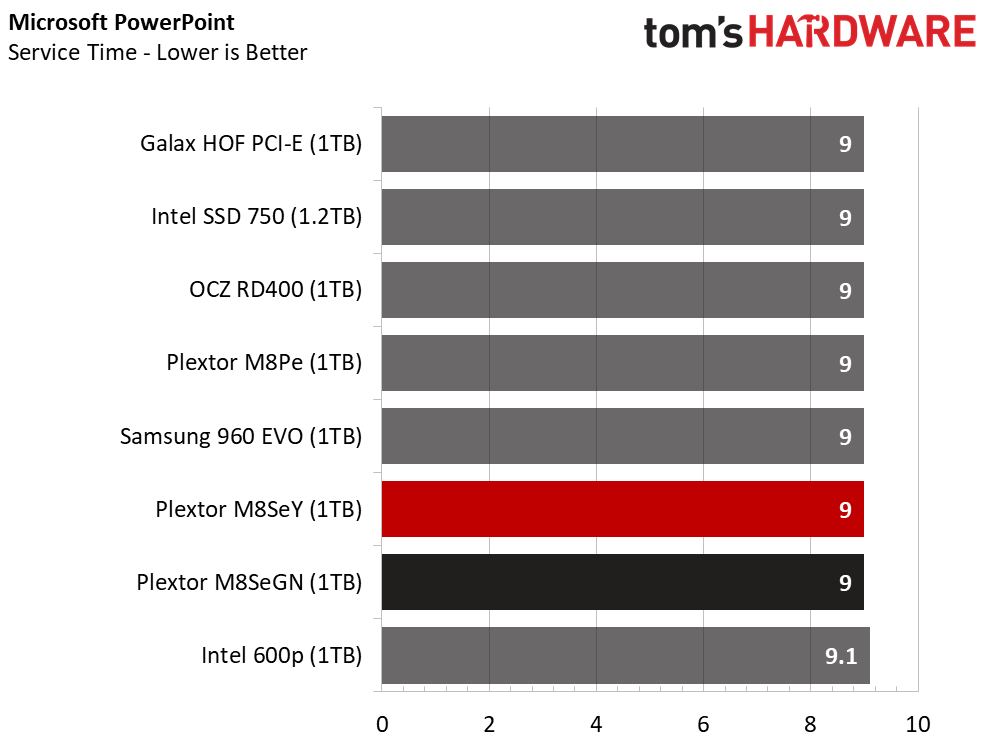
The M8Se drives fall to the bottom of the charts in many of these tests, but we finally begin to see some measurable differences between the heatsink and "bare" models.
Application Storage Bandwidth
The performance is the real story here, though, as the M8Se struggles to keep pace with the MLC-based M8Pe. For Plextor to be successful with this series, it either has to outperform the competition or cost significantly less than the Samsung 960 EVO. The M8Se MSRP is lower than the 960 EVO with for all but the AIC model, but there is only a slight difference in 1TB pricing.
PCMark 8 Advanced Workload Performance
To learn how we test advanced workload performance, pleaseclick here.

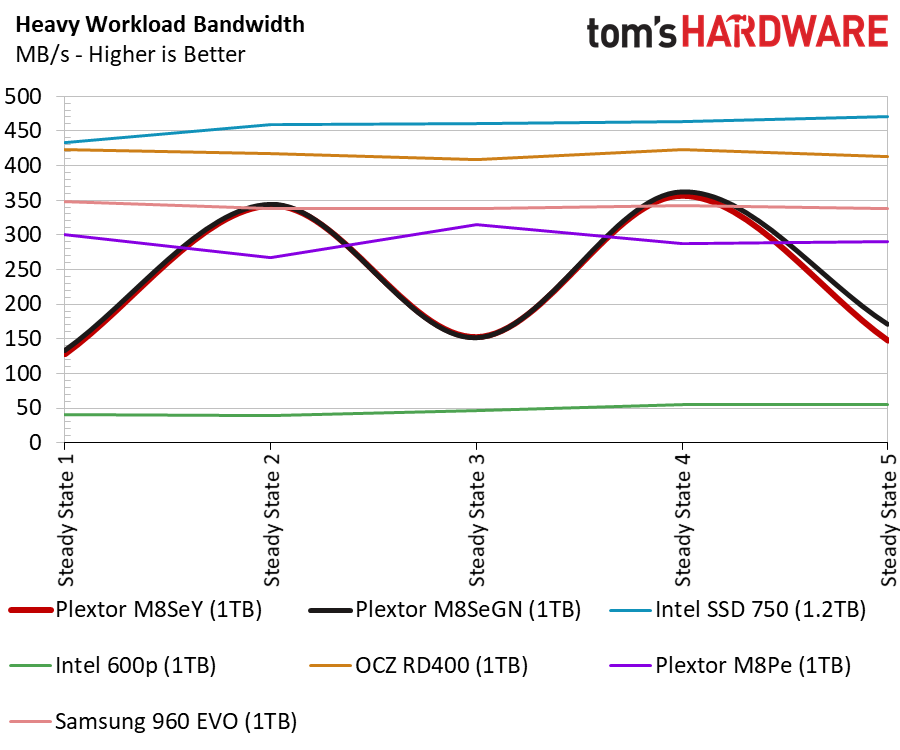

Both the heatsink-equipped and bare M8Se drives delivered very inconsistent performance during extended workloads. You wouldn't want this to happen with professional software, and most users wouldn't want this to happen during daily use.
Total Service Time


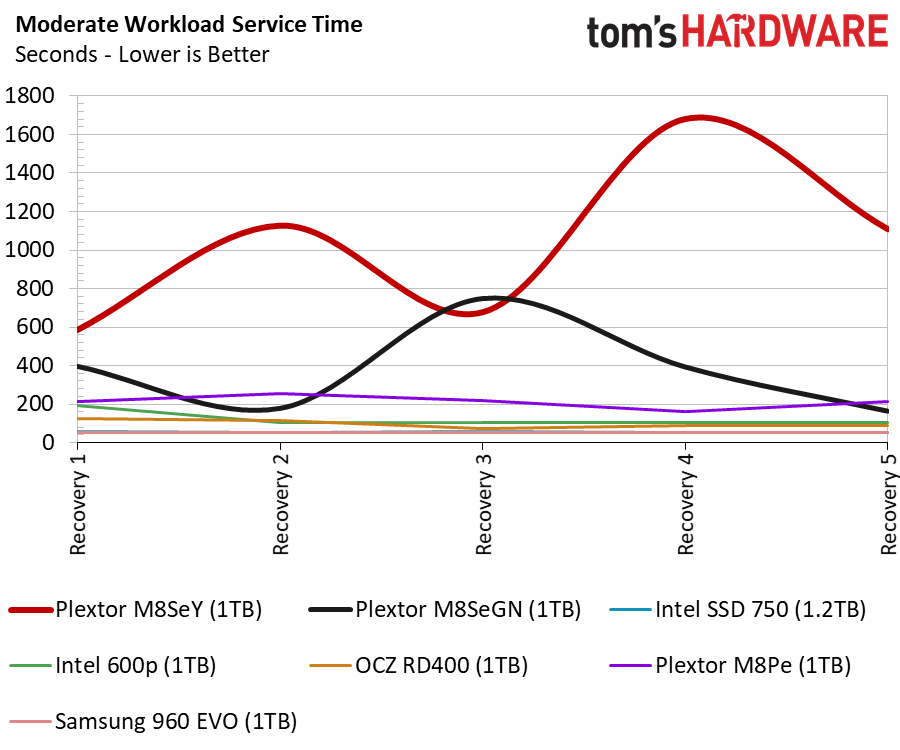
Latency causes large spikes during the SSDs' internal cleanup operations. There just isn't enough processing power to simultaneously clean the flash cells and read/write data at the same time. TLC is slow at native speeds, which doesn't help reduce the background process time.
Disk Busy Time
The disk busy time test shows just how insane the latency outliers actually are. Some test runs take twice as long to finish compared to other products. That can increase even more on occasion. We found a long dose of idle time doesn't seem to fix the issue.
Responsiveness Test
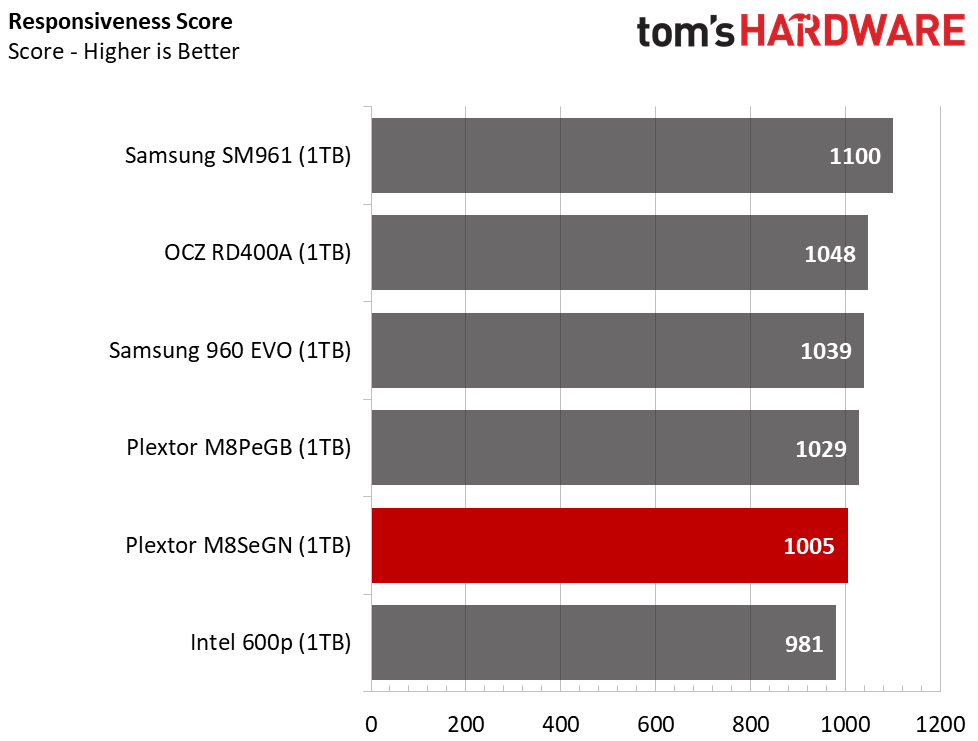

The Responsiveness Test from SYSmark 2014 SE runs on our Lenovo Y700-17 notebooks. Of course, notebooks don't support add-in card form factors. Accordingly, we only ran the M8SeGB without a heat sink for these tests. The M8Se series delivers a slightly better user experience compared to the Intel 600p, but there are plenty of NVMe SSDs that are better and cheaper.
Notebook Battery Life


The M8SeGN is a power sucking monster that can consume more than an extra hour worth of battery power compared to the Samsung SM961 and Plextor M8Pe. It seems Plextor didn't spend much time optimizing this product before releasing it to the public.
MORE: Best SSDs
MORE: How We Test HDDs And SSDs
MORE: All SSD Content
Current page: 1TB NVMe SSD Performance
Prev Page Features & Specifications Next Page 512GB NVMe SSD Performance
Chris Ramseyer was a senior contributing editor for Tom's Hardware. He tested and reviewed consumer storage.
-
AgentLozen This is really disappointing. I've held Plextor in high regard for the last few years so it's a shame this thing is around to soil it's reputation.Reply
The review indicates that it's professional SSD still performs quite well. Maybe Plextor never intended for this new drive to win any awards.
Good review. -
derekullo You’re not quite Samsung enough.Reply
You’re semi-Samsung.
You’re quasi-Samsung.
You’re the margarine of Samsung.
You’re the Diet Coke of Samsung just one calorie, not Samsung enough.
In all fairness, Plextor is just playing their part in the race to the bottom. -
cinergy Why does shamesung continue to dominate? I don't want to buy their products but I don't see much choice...Reply -
derekullo Because they have the fastest most power efficient NAND due to being able to make it themself.Reply
Most other companies order the NAND from a 3rd party supplier and add their own custom firmware for flavor. -
daglesj Does 'Plextor' actually make anything themselves? I mean all they did 20 years ago was flash upgraded firmware on other peoples optical drives and change the front bezel.Reply -
Faslane1966 I dunno. Plextor hasn't been the greatest name in tech for a while now (not to be confused with God awful Maxtor) but I'd still be wary of these until more reviews and tests come out. Just me personally. They haven't been in the SSD business long at all if ever that I've seen.Reply -
none12345 Man they went from the m8pe being on top in some benchmarks and competitive in others to the bottom with the m8se. WTF did they do....Reply
TLC garbage is not good for consumers!
On top of that the se going for $290 for 512gb nvme version on newegg as of this post. Last month i got a m8pe for $215(tho this was a sale price). $75 more for less performance ouch.
Ive had good luck with plextor ssds the last few years. Never a problem, which is why i got a m8pe over a samsung 960. But, i wouldnt touch the m8se. -
HERETIC-1 To DAGLESJ and FASLANE-Reply
To the best of my knowledge PLEXTOR is now owned by Lite-on.
So expect some high quality gems (Plextor) and some general
purpose drives designed for OEM market (Lite-on) -
gasaraki TLC is garbage, stop push these garbage on to us. SSDs have gotten worst and worst over the years. Now they want us to use QLC soon. Over my dead body. I'll hold on to my MLC BPX till I die.Reply




